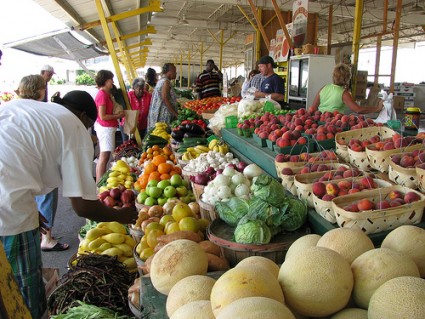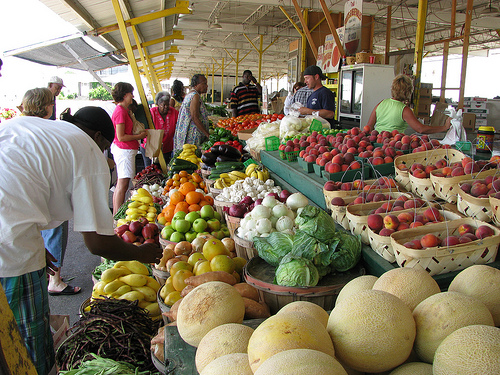 Want farmers market food to expand beynd niche status? We need to invest in infrastructure. Photo: Natalie Maynor, Flickr Creative CommonsWhen The New York Times invited me to participate in a “Room for Debate” forum on the infrastructure problem in agriculture, I wrote a 1400-word treatise (a Tolstoyan length in online-debate terms), before slashing it down to the required 400 words. To see the forum, with its variety of perspectives, go here. Below is the uncut version of my entry–the culmination of years of thinking about one major obstacle to the sustainable-food/food-justice movement.
Want farmers market food to expand beynd niche status? We need to invest in infrastructure. Photo: Natalie Maynor, Flickr Creative CommonsWhen The New York Times invited me to participate in a “Room for Debate” forum on the infrastructure problem in agriculture, I wrote a 1400-word treatise (a Tolstoyan length in online-debate terms), before slashing it down to the required 400 words. To see the forum, with its variety of perspectives, go here. Below is the uncut version of my entry–the culmination of years of thinking about one major obstacle to the sustainable-food/food-justice movement.
———-
To enter a farmers’ market in a U.S. city in the summer is to experience firsthand the recent revival of small-scale farming. Stand after stand offers a dazzling variety of chemical-free produce, pasture-raised meat and eggs, farmstead cheeses, and more.
Yet in a sense, our teeming, bountiful farmers markets amount to a gloss on a food system that rewards scale and cheapness over all other factors–including quality, nutrition, ecological sustainability, social justice, and a sense of place. While farmers markets, community-supported agriculture (CSA) programs, and “locavore” restaurants have proliferated over the past decade, they still provide just a tiny portion of the calories consumed by Americans.
Indeed, for all the foment of recent years, local and regional food networks occupy a small niche within a highly industrialized, extractive, and globe-spanning agri-food system. Moving beyond niche status will require significant investments in infrastructure that can link the growing number of small and mid-sized farms to the growing number of consumers who want to eat within their foodsheds and support ecologically sound agriculture.
Already, the infrastructure gap is constraining the local-food movement. We see it glaringly in the market for meat, where a widespread shortage of USDA-inspected slaughterhouses is causing supply bottlenecks and forcing farmers to “scale back on plans to expand their farms because local processors cannot handle any more animals,” as The New York Times recently reported.
Dairy offers an even starker case. With a few companies processing the great bulk of milk consumed in the United States, processing facilities are few and far between. Most dairy farmers have little choice but to accept the miserly prices the large firms offer. Just at the time when consumers are demanding local milk from grass-fed cows, small-scale dairy farming is mired in a state of perpetual crisis: surviving farms languish under severe pressure to either scale up dramatically or exit the business altogether.
How did we reach this pass? In short, a very few companies have managed to gain ever greater control over food processing in this country–and as they gobble market share, they shutter small facilities and consolidate operations into vast centralized factories.
One way to measure the level of corporate consolidation is to look at the amount of market share owned by the top four firms in a given market–a metric known as CR4. In antitrust theory, when CR4 surpasses 40 percent–that is, when four firms control more than 40 percent of a market–these giant players wield unfair power to dictate terms to their suppliers (in this case, farmers).
The University of Missouri rural sociologist Mary Hendrickson and William Heffernan track consolidation of food markets. According to their latest report , CR4 for the beef industry rose from 72 percent in 1990 to 83.5 percent in 2005. Since then, Brazilian beef giant JBS bought out that market’s third- and fifth-largest players. This means that just three companies–Tyson, Cargill, and JBS–slaughter close to 90 percent of the cows raised in this country.
CR4 levels for pork, chicken, and turkey all exceed 50 percent–and all have risen dramatically in the past 25 years, Hendrickson and Heffernan show. Information on concentration in the dairy market is hard to come by, but we do know that a single company, Dean Foods, “bottles 33 percent of U.S. fluid milk,” according to a 2008 report from the USDA’s Economic Research Service (ERS). In some regions, concentration is even more intense. Just two companies, Dean and Hood, bottle 90 percent of the milk produced in the northeast, the ERS report states.
These stunning levels of concentration have translated directly to a shuttering of the far-flung network of slaughterhouses and dairy-bottling plants that once served small diversified farms and tied them to nearby consumers. According to another ERS report, the number of nationwide dairy-processing facilities plunged from 2507 in 1972 to 524 in 2002–an 80 percent wipeout in just three decades. And between 1994 and 2004, the nation surrendered 20 percent of slaughterhouses for pigs and 22 percent of those for cattle.
As facilities close, farmers have to ship their livestock and milk longer and longer distances for processing–adding significantly to their costs and to the carbon footprint of their products (to speak nothing of the stress animals are subjected to by long trips in the back of a truck).
The question now is, what to do about this great withering away of the means of food production? The response from conventional economists is: Let the market fix itself. If people want local, pasture-raised meat and dairy, they’ll flock to the farmers market to buy it, and farmers will take their extra profits and invest in their own facilities. But people are flocking to farmers markets; the problem is, profit margins on small-scale farming remain so tight that few farms have cash to spare on such investments.
We’re moving towards a classic market failure: We see increasing demand for locally and sustainable grown farm products, increasing desire among farmers to meet that demand– and an infrastructural gulf separating them.
The proper response to a market failure is government action. Libertarians and food-industry advocates will scoff; but they have to reckon with the stark fact that federal action is largely responsible for the current state of affairs. The government looked the other way while the food industry consolidated beyond any reasonable level.
Moreover, the government has supported the meat industry through its notoriously lax enforcement of environmental code for concentrated animal feedlot operations (CAFOs). Unlike industrial waste and other major ecosystem-destroying pollutants, manure accumulated from CAFOs has for decades avoided strict government oversight, a Washington Post story recently showed. The newspaper concluded: “The Obama administration has made moves to change that but already has found itself facing off with farm interests, entangled in the contentious politics of poop.”
Labor abuse at factory-scale slaughter facilities has also gone largely unchecked. By 2005, labor conditions in the meat-processing industry had become so routinely abysmal that Human Rights Watch–which normally focuses on monitoring foreign dictatorships–saw fit to issue a damning report. “Meat-packing is the most dangerous factory job in America,” HRW declared. “Dangerous conditions are cheaper for companies — and the government does next to nothing.” The HRW report also documents meatpackers’ tireless efforts to crush unions.
Then there’s the food-safety issue. The federal government has refused to regulate the use of antibiotics in industrial livestock farming. Routine, unrestrained use of antibiotics allows operators to stuff ever more animals together under unsanitary conditions, and contributes massively to the explosion of antibiotic-resistant pathogens. Federal regulators have also brushed off years of warnings by researchers that industrial hog farming provides an ideal environment for novel strains of swine flu–even after the 2009 H1N1 outbreak. Then there’s the recent bombshell from the USDA’s Inspector General, which revealed that federal inspectors knowingly allow the meat industry to release product tainted with industrial and pharmaceutical poisons.
Finally, the most direct way the government props up the meat industry is by encouraging maximum production of corn and soy–the key components of industrial livestock feed. Most critics of agricultural subsidies denounce them as welfare for farmers. In reality, their benefits accrue mainly to the entities that turn cheap feed into meat. For most of the 1997-2005 period, farmers overproduced corn and soy to such a level that market prices fell below the cost of production. The government made up the difference with subsidies–and the meat industry benefited from a bonanza of cheap feed. According to a 2007 study by Tufts researchers, federal subsidies saved meat, dairy, and egg processors a stunning $34.7 billion in feed costs over that period–which was, as we’ve seen, a time of rapid consolidation.
To sum: Without a cheap-corn policy and a regulatory environment that allows the meat industry to externalize billions of dollars in ecological, human-rights, and public-health messes each year, it’s highly unlikely that our food system could ever have gotten as centralized as it is now. Thus federal action (and inaction) is largely to blame for our infrastructure mess–and it will take federal action to fix it. The Obama administration has indicated that it will consider taking antitrust action to remedy food-industry consolidation. Despite that new-found zeal, federal antitrust authorities did not object last year when JBS, now the globe’s largest meat producer, bought Pilgrim’s Pride, the second largest U.S. poultry packer. That move gave JBS massive positions in the U.S. beef, pork, and poultry markets.
And true, the USDA is now commendably giving grants to farmers to invest in appropriate-scale slaughter facilities. But that effort, part of the USDA’s Know Your Farmer, Know Your Food program, amounts to pennies on the dollar compared to crop subsidies or support for corn ethanol. And it seems wholly inadequate to the massive task at hand.
If we want to see local and regional food systems expand beyond niche status–and make the bounty of the farmers market available to more than just a relative few–then we need to demand that the federal government crack down on the meat and dairy industries’ shady environmental and labor practices. And we need a serious program to reinvest in the infrastructure that has been so cavalierly dismantled–perhaps through a federal grant program funded by fines against offending corporate giants.


